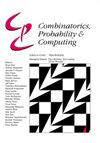稀疏随机矩阵的奇异性:简单证明
IF 0.8
4区 数学
Q3 COMPUTER SCIENCE, THEORY & METHODS
引用次数: 10
摘要
考虑一个随机的$n\times n$ 0 - 1矩阵,其“稀疏度”为p,根据以下两种模型之一进行采样:要么每个条目都以p的概率独立地取为1(“伯努利”模型),要么从所有长度为n的0 - 1向量的集合中独立均匀地采样每一行,这些向量恰好是pn个(“组合”模型)。我们给出了简单的(本质上最好的)事实证明,在这两个模型中,如果$\min(p,1-p)\geq (1+\varepsilon)\log n/n$对于任意常数$\varepsilon>0$,那么我们的随机矩阵是非奇异的,概率为$1-o(1)$。在伯努利模型中,这个事实是众所周知的,但在组合模型中,这解决了Aigner-Horev和Person的一个猜想。本文章由计算机程序翻译,如有差异,请以英文原文为准。
Singularity of sparse random matrices: simple proofs
Consider a random
$n\times n$
zero-one matrix with ‘sparsity’ p, sampled according to one of the following two models: either every entry is independently taken to be one with probability p (the ‘Bernoulli’ model) or each row is independently uniformly sampled from the set of all length-n zero-one vectors with exactly pn ones (the ‘combinatorial’ model). We give simple proofs of the (essentially best-possible) fact that in both models, if
$\min(p,1-p)\geq (1+\varepsilon)\log n/n$
for any constant
$\varepsilon>0$
, then our random matrix is nonsingular with probability
$1-o(1)$
. In the Bernoulli model, this fact was already well known, but in the combinatorial model this resolves a conjecture of Aigner-Horev and Person.
求助全文
通过发布文献求助,成功后即可免费获取论文全文。
去求助
来源期刊

Combinatorics, Probability & Computing
数学-计算机:理论方法
CiteScore
2.40
自引率
11.10%
发文量
33
审稿时长
6-12 weeks
期刊介绍:
Published bimonthly, Combinatorics, Probability & Computing is devoted to the three areas of combinatorics, probability theory and theoretical computer science. Topics covered include classical and algebraic graph theory, extremal set theory, matroid theory, probabilistic methods and random combinatorial structures; combinatorial probability and limit theorems for random combinatorial structures; the theory of algorithms (including complexity theory), randomised algorithms, probabilistic analysis of algorithms, computational learning theory and optimisation.
 求助内容:
求助内容: 应助结果提醒方式:
应助结果提醒方式:


